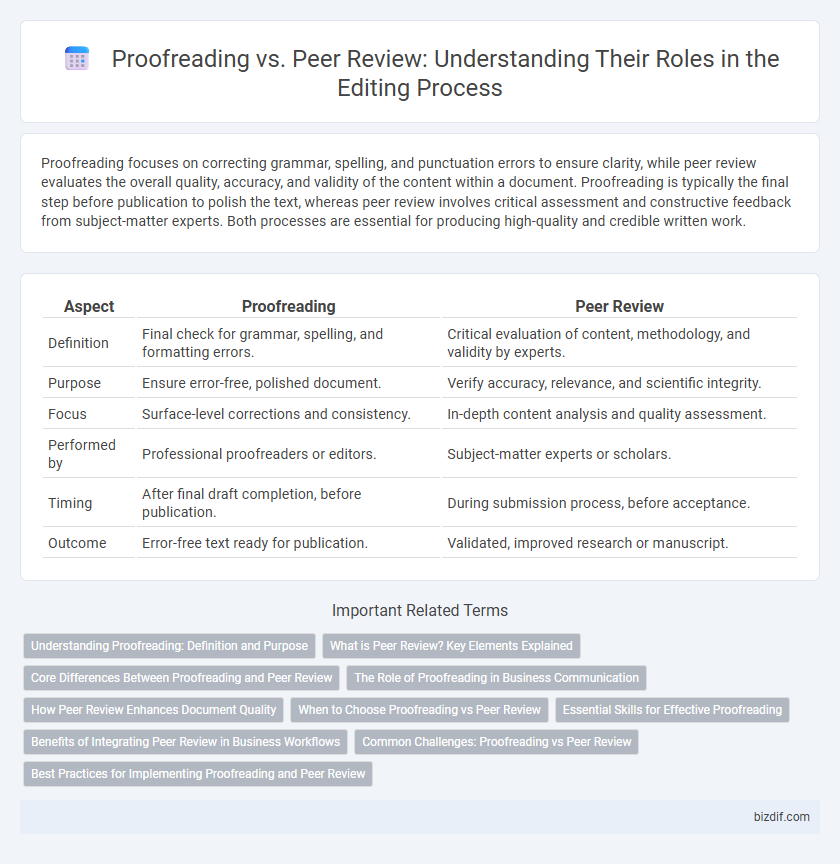Proofreading focuses on correcting grammar, spelling, and punctuation errors to ensure clarity, while peer review evaluates the overall quality, accuracy, and validity of the content within a document. Proofreading is typically the final step before publication to polish the text, whereas peer review involves critical assessment and constructive feedback from subject-matter experts. Both processes are essential for producing high-quality and credible written work.
Table of Comparison
| Aspect | Proofreading | Peer Review |
|---|---|---|
| Definition | Final check for grammar, spelling, and formatting errors. | Critical evaluation of content, methodology, and validity by experts. |
| Purpose | Ensure error-free, polished document. | Verify accuracy, relevance, and scientific integrity. |
| Focus | Surface-level corrections and consistency. | In-depth content analysis and quality assessment. |
| Performed by | Professional proofreaders or editors. | Subject-matter experts or scholars. |
| Timing | After final draft completion, before publication. | During submission process, before acceptance. |
| Outcome | Error-free text ready for publication. | Validated, improved research or manuscript. |
Understanding Proofreading: Definition and Purpose
Proofreading is the final step in the editing process focused on identifying and correcting surface errors such as typos, grammatical mistakes, and formatting inconsistencies. Unlike peer review, which evaluates the overall content quality, argument strength, and research validity, proofreading aims to ensure clarity and accuracy by polishing language and presentation. Its primary purpose is to produce a clean, professional, and error-free document suitable for publication or submission.
What is Peer Review? Key Elements Explained
Peer review is a critical evaluation process where experts in the same field assess a manuscript or research work for accuracy, validity, and originality before publication. Key elements include thorough scrutiny of methodology, verification of data integrity, and constructive feedback aimed at enhancing the study's clarity and credibility. This process ensures the research meets established academic standards and contributes valuable knowledge to its discipline.
Core Differences Between Proofreading and Peer Review
Proofreading involves meticulous error correction of grammar, spelling, punctuation, and formatting to ensure a polished final document. Peer review evaluates the content's accuracy, methodology, originality, and scholarly value, often providing critical feedback for improvement. The core difference lies in proofreading's focus on surface-level language accuracy, while peer review centers on the substantive quality and validity of the work.
The Role of Proofreading in Business Communication
Proofreading in business communication ensures error-free documents by correcting grammar, spelling, and punctuation, which enhances clarity and professionalism. It plays a critical role in maintaining the credibility of corporate messages and preventing misunderstandings in internal and external communications. Unlike peer review that focuses on content accuracy and substantive feedback, proofreading targets surface-level errors to polish the final presentation.
How Peer Review Enhances Document Quality
Peer review enhances document quality by involving multiple experts who evaluate content accuracy, coherence, and relevance, ensuring the work meets academic or professional standards. This collaborative process identifies errors, gaps, and biases that a single proofreader might overlook, thereby strengthening the document's credibility and depth. Peer review also fosters constructive feedback, enabling authors to refine arguments and improve overall clarity.
When to Choose Proofreading vs Peer Review
Choose proofreading when you need to correct grammar, spelling, punctuation, and formatting errors in a nearly final draft to ensure clarity and polish. Opt for peer review during the early or intermediate stages of writing to receive in-depth feedback on content accuracy, argument strength, and overall structure from subject-matter experts. Prioritizing proofreading before publication guarantees a professional finish, while peer review enhances the document's scholarly credibility and coherence.
Essential Skills for Effective Proofreading
Effective proofreading requires keen attention to detail, a strong grasp of grammar and punctuation rules, and the ability to spot inconsistencies in formatting and style. Unlike peer review, which assesses content validity and argument strength, proofreading zeroes in on surface-level errors such as typos, spelling mistakes, and syntax issues. Mastery of these essential skills ensures clarity, professionalism, and accuracy in the final written document.
Benefits of Integrating Peer Review in Business Workflows
Integrating peer review into business workflows enhances accuracy by incorporating multiple perspectives, reducing errors, and improving content quality beyond basic proofreading. Peer review facilitates constructive feedback, fostering collaboration and continuous improvement in documents and projects. This process supports better decision-making and increases stakeholder confidence, ultimately driving higher standards and efficiencies across business operations.
Common Challenges: Proofreading vs Peer Review
Proofreading and peer review both aim to enhance the quality of written content but face distinct challenges; proofreading primarily deals with identifying grammatical errors, typographical mistakes, and formatting inconsistencies, while peer review focuses on evaluating the content's accuracy, logic, and overall coherence. Proofreaders often struggle with detecting subtle subtle semantic inaccuracies and context-dependent errors that require subject-matter expertise, which peer reviewers bring to the process. Balancing thoroughness and efficiency remains a shared challenge, as both proofreading and peer review demand careful attention to detail without causing significant delays in publication timelines.
Best Practices for Implementing Proofreading and Peer Review
Effective implementation of proofreading involves meticulous error detection, focusing on grammar, punctuation, and spelling to ensure clarity and professionalism. Best practices for peer review emphasize constructive feedback on content accuracy, coherence, and originality, fostering collaborative improvement and adherence to academic or professional standards. Integrating both processes enhances overall quality by combining detailed linguistic corrections with substantive content evaluation.
Proofreading vs Peer Review Infographic

 bizdif.com
bizdif.com